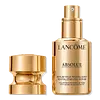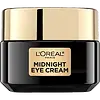What's inside
What's inside
 Key Ingredients
Key Ingredients

 Benefits
Benefits

 Concerns
Concerns

 Ingredients Side-by-side
Ingredients Side-by-side

Water
Skin ConditioningPropanediol
SolventBifida Ferment Lysate
Skin ConditioningGlycerin
HumectantAlcohol Denat.
AntimicrobialBis-PEG-18 Methyl Ether Dimethyl Silane
EmollientDimethicone
EmollientPEG-20
HumectantAcacia Senegal Gum
MaskingPEG/PPG/Polybutylene Glycol-8/5/3 Glycerin
HumectantLimnanthes Alba Seed Oil
Skin ConditioningVinyl Dimethicone/Methicone Silsesquioxane Crosspolymer
Hydroxyethylpiperazine Ethane Sulfonic Acid
BufferingCI 77891
Cosmetic ColorantMica
Cosmetic ColorantHydroxypropyl Tetrahydropyrantriol
Skin ConditioningHydrogenated Lecithin
EmulsifyingSodium Hyaluronate
HumectantSodium Benzoate
MaskingSodium Hydroxide
BufferingHydrolyzed Linseed Extract
Skin ConditioningPhenoxyethanol
PreservativeAdenosine
Skin ConditioningCaffeine
Skin ConditioningPPG-3 Myristyl Ether
EmollientSilica
AbrasiveChlorella Vulgaris Extract
Skin ConditioningDimethicone/Vinyl Dimethicone Crosspolymer
Skin ConditioningAmmonium Polyacryloyldimethyl Taurate
Emulsion StabilisingXanthan Gum
EmulsifyingPanthenol
Skin ConditioningPentylene Glycol
Skin ConditioningPropylene Glycol
HumectantCaprylyl Glycol
EmollientCarbomer
Emulsion StabilisingGeraniol
PerfumingJasminum Officinale Flower Extract
MaskingRosa Damascena Flower Oil
MaskingRosa Centifolia Flower Extract
AstringentBHT
AntioxidantCitronellol
PerfumingWater, Propanediol, Bifida Ferment Lysate, Glycerin, Alcohol Denat., Bis-PEG-18 Methyl Ether Dimethyl Silane, Dimethicone, PEG-20, Acacia Senegal Gum, PEG/PPG/Polybutylene Glycol-8/5/3 Glycerin, Limnanthes Alba Seed Oil, Vinyl Dimethicone/Methicone Silsesquioxane Crosspolymer, Hydroxyethylpiperazine Ethane Sulfonic Acid, CI 77891, Mica, Hydroxypropyl Tetrahydropyrantriol, Hydrogenated Lecithin, Sodium Hyaluronate, Sodium Benzoate, Sodium Hydroxide, Hydrolyzed Linseed Extract, Phenoxyethanol, Adenosine, Caffeine, PPG-3 Myristyl Ether, Silica, Chlorella Vulgaris Extract, Dimethicone/Vinyl Dimethicone Crosspolymer, Ammonium Polyacryloyldimethyl Taurate, Xanthan Gum, Panthenol, Pentylene Glycol, Propylene Glycol, Caprylyl Glycol, Carbomer, Geraniol, Jasminum Officinale Flower Extract, Rosa Damascena Flower Oil, Rosa Centifolia Flower Extract, BHT, Citronellol
Water
Skin ConditioningDimethicone
EmollientGlycerin
HumectantIsohexadecane
EmollientAlcohol Denat.
AntimicrobialButyrospermum Parkii Butter
Skin ConditioningSqualane
EmollientCetyl Alcohol
EmollientStearic Acid
CleansingPalmitic Acid
EmollientGlyceryl Stearate
EmollientPEG-100 Stearate
PEG-20 Stearate
EmulsifyingSaccharomyces/Xylinum/Black Tea Ferment
Skin ConditioningCera Alba
EmollientOctyldodecanol
EmollientHydrolyzed Soy Protein
HumectantAcetyl Tetrapeptide-9
Skin ConditioningAdenosine
Skin ConditioningCaffeine
Skin ConditioningCapryloyl Salicylic Acid
ExfoliatingSecale Cereale Seed Extract
AbrasiveSodium Hyaluronate
HumectantSodium Hydroxide
BufferingTrisodium Ethylenediamine Disuccinate
Tocopherol
AntioxidantSilica
AbrasiveCI 77891
Cosmetic ColorantCitric Acid
BufferingC13-14 Isoparaffin
EmollientGlycine Soja Oil
EmollientLaureth-7
EmulsifyingMica
Cosmetic ColorantMyristic Acid
CleansingPentylene Glycol
Skin ConditioningPolyacrylamide
Tin Oxide
AbrasiveDimethiconol
EmollientCI 16035
Cosmetic ColorantCI 19140
Cosmetic ColorantChlorhexidine Digluconate
AntimicrobialChlorphenesin
AntimicrobialPhenoxyethanol
PreservativePotassium Sorbate
PreservativeSodium Benzoate
MaskingWater, Dimethicone, Glycerin, Isohexadecane, Alcohol Denat., Butyrospermum Parkii Butter, Squalane, Cetyl Alcohol, Stearic Acid, Palmitic Acid, Glyceryl Stearate, PEG-100 Stearate, PEG-20 Stearate, Saccharomyces/Xylinum/Black Tea Ferment, Cera Alba, Octyldodecanol, Hydrolyzed Soy Protein, Acetyl Tetrapeptide-9, Adenosine, Caffeine, Capryloyl Salicylic Acid, Secale Cereale Seed Extract, Sodium Hyaluronate, Sodium Hydroxide, Trisodium Ethylenediamine Disuccinate, Tocopherol, Silica, CI 77891, Citric Acid, C13-14 Isoparaffin, Glycine Soja Oil, Laureth-7, Mica, Myristic Acid, Pentylene Glycol, Polyacrylamide, Tin Oxide, Dimethiconol, CI 16035, CI 19140, Chlorhexidine Digluconate, Chlorphenesin, Phenoxyethanol, Potassium Sorbate, Sodium Benzoate
Ingredients Explained
These ingredients are found in both products.
Ingredients higher up in an ingredient list are typically present in a larger amount.
Adenosine is in every living organism. It is one of four components in nucleic acids that helps store our DNA.
Adenosine has many benefits when used. These benefits include hydrating the skin, smoothing skin, and reducing wrinkles. Once applied, adenosine increases collagen production. It also helps with improving firmness and tissue repair.
Studies have found adenosine may also help with wound healing.
In skincare products, Adenosine is usually derived from yeast.
Learn more about AdenosineAlcohol Denat. is an alcohol with a denaturant property. It is created by mixing ethanol with other additives.
This ingredient gets a bad rep because it is irritating and drying - mostly due to its astringent property. Astringents draw out natural oils in tissue, constricting pores and leaving your skin dried out.
However, alcohol denat. is not all that bad.
Due to its low molecular weight, alcohol denat. tends to evaporate quickly. One study on pig skin found half of applied alcohol evaporated in 10 seconds and less than 3% stayed on skin.
This also helps other ingredients become better absorbed upon application.
Studies are conflicted about whether this ingredient causes skin dehydration. One study from 2005 found adding emollients to propanol-based sanitizer decreased skin dryness and irritation. Another study found irritation only occurs if your skin is already damaged.
Small amounts of alcohol are generally tolerated by oily skin or people who live in humid environments.
The rule of thumb is if this alcohol is near the end of an ingredients list, it will probably not affect your skin much.
Also...
This ingredient has antimicrobial and solvent properties.
The antimicrobial property helps preserve products and increase their shelf life. As a solvent, it helps dissolve other ingredients.
Other types of astringent alcohols include:
Learn more about Alcohol Denat.Caffeine is most associated with coffee, tea, and cacao. In skincare, it helps with calming inflammation and is rich in antioxidants.
While caffeine is used to treat cellulite and and dark circles, further studies are needed to prove this. It has been believed to help with these skin conditions due to its ability to dilate blood vessels and increase blood flow.
Some studies are looking into caffeine's ability to protect against UV rays.
Learn more about CaffeineCi 77891 is a white pigment from Titanium dioxide. It is naturally found in minerals such as rutile and ilmenite.
It's main function is to add a white color to cosmetics. It can also be mixed with other colors to create different shades.
Ci 77891 is commonly found in sunscreens due to its ability to block UV rays.
Learn more about CI 77891Dimethicone is a type of synthetic silicone created from natural materials such as quartz.
What it does:
Dimethicone comes in different viscosities:
Depending on the viscosity, dimethicone has different properties.
Ingredients lists don't always show which type is used, so we recommend reaching out to the brand if you have questions about the viscosity.
This ingredient is unlikely to cause irritation because it does not get absorbed into skin. However, people with silicone allergies should be careful about using this ingredient.
Note: Dimethicone may contribute to pilling. This is because it is not oil or water soluble, so pilling may occur when layered with products. When mixed with heavy oils in a formula, the outcome is also quite greasy.
Learn more about DimethiconeGlycerin is already naturally found in your skin. It helps moisturize and protect your skin.
A study from 2016 found glycerin to be more effective as a humectant than AHAs and hyaluronic acid.
As a humectant, it helps the skin stay hydrated by pulling moisture to your skin. The low molecular weight of glycerin allows it to pull moisture into the deeper layers of your skin.
Hydrated skin improves your skin barrier; Your skin barrier helps protect against irritants and bacteria.
Glycerin has also been found to have antimicrobial and antiviral properties. Due to these properties, glycerin is often used in wound and burn treatments.
In cosmetics, glycerin is usually derived from plants such as soybean or palm. However, it can also be sourced from animals, such as tallow or animal fat.
This ingredient is organic, colorless, odorless, and non-toxic.
Glycerin is the name for this ingredient in American English. British English uses Glycerol/Glycerine.
Learn more about GlycerinMica is a naturally occurring mineral used to add shimmer and color in cosmetics. It can also help improve the texture of a product or give it an opaque, white/silver color.
Serecite is the name for very fine but ragged grains of mica.
This ingredient is often coated with metal oxides like titanium dioxide. Trace amounts of heavy metals may be found in mica, but these metals are not harmful in our personal products.
Mica has been used since prehistoric times throughout the world. Ancient Egyptian, Indian, Greek, Roman, Aztec, and Chinese civilizations have used mica.
Learn more about MicaPentylene glycol is typically used within a product to thicken it. It also adds a smooth, soft, and moisturizing feel to the product. It is naturally found in plants such as sugar beets.
The hydrophilic trait of Pentylene Glycol makes it a humectant. As a humectant, Pentylene Glycol helps draw moisture from the air to your skin. This can help keep your skin hydrated.
This property also makes Pentylene Glycol a great texture enhancer. It can also help thicken or stabilize a product.
Pentylene Glycol also acts as a mild preservative and helps to keep a product microbe-free.
Some people may experience mild eye and skin irritation from Pentylene Glycol. We always recommend speaking with a professional about using this ingredient in your routine.
Pentylene Glycol has a low molecular weight and is part of the 1,2-glycol family.
Learn more about Pentylene GlycolPhenoxyethanol is a preservative that has germicide, antimicrobial, and aromatic properties. Studies show that phenoxyethanol can prevent microbial growth. By itself, it has a scent that is similar to that of a rose.
It's often used in formulations along with Caprylyl Glycol to preserve the shelf life of products.
Silica, also known as silicon dioxide, is a naturally occurring mineral. It is used as a fine, spherical, and porous powder in cosmetics.
Though it has exfoliant properties, the function of silica varies depending on the product.
The unique structure of silica enhances the spreadability and adds smoothness, making it a great texture enhancer.
It is also used as an active carrier, emulsifier, and mattifier due to its ability to absorb excess oil.
In some products, tiny microneedles called spicules are made from silica or hydrolyzed sponge. When you rub them in, they lightly polish away dead skin layers and enhance the penetration of active ingredients.
Learn more about SilicaSodium Benzoate is a preservative. It's used in both cosmetic and food products to inhibit the growth of mold and bacteria. It is typically produced synthetically.
Both the US FDA and EU Health Committee have approved the use of sodium benzoate. In the US, levels of 0.1% (of the total product) are allowed.
Sodium benzoate works as a preservative by inhibiting the growth of bacteria inside of cells. It prevents the cell from fermenting a type of sugar using an enzyme called phosphofructokinase.
It is the salt of benzoic acid. Foods containing sodium benzoate include soda, salad dressings, condiments, fruit juices, wines, and snack foods.
Studies for using ascorbic acid and sodium benzoate in cosmetics are lacking, especially in skincare routines with multiple steps.
We always recommend speaking with a professional, such as a dermatologist, if you have any concerns.
Learn more about Sodium BenzoateSodium Hyaluronate is hyaluronic acid's salt form. It is commonly derived from the sodium salt of hyaluronic acid.
Like hyaluronic acid, it is great at holding water and acts as a humectant. This makes it a great skin hydrating ingredient.
Sodium Hyaluronate is naturally occurring in our bodies and is mostly found in eye fluid and joints.
These are some other common types of Hyaluronic Acid:
Learn more about Sodium HyaluronateSodium Hydroxide is also known as lye or caustic soda. It is used to adjust the pH of products; many ingredients require a specific pH to be effective.
In small amounts, sodium hydroxide is considered safe to use. However, large amounts may cause chemical burns due to its high alkaline.
Your skin has a natural pH and acid mantle. This acid mantle helps prevent harmful bacteria from breaking through. The acid mantle also helps keep your skin hydrated.
"Alkaline" refers to a high pH level. A low pH level would be considered acidic.
Learn more about Sodium HydroxideWater. It's the most common cosmetic ingredient of all. You'll usually see it at the top of ingredient lists, meaning that it makes up the largest part of the product.
So why is it so popular? Water most often acts as a solvent - this means that it helps dissolve other ingredients into the formulation.
You'll also recognize water as that liquid we all need to stay alive. If you see this, drink a glass of water. Stay hydrated!
Learn more about Water